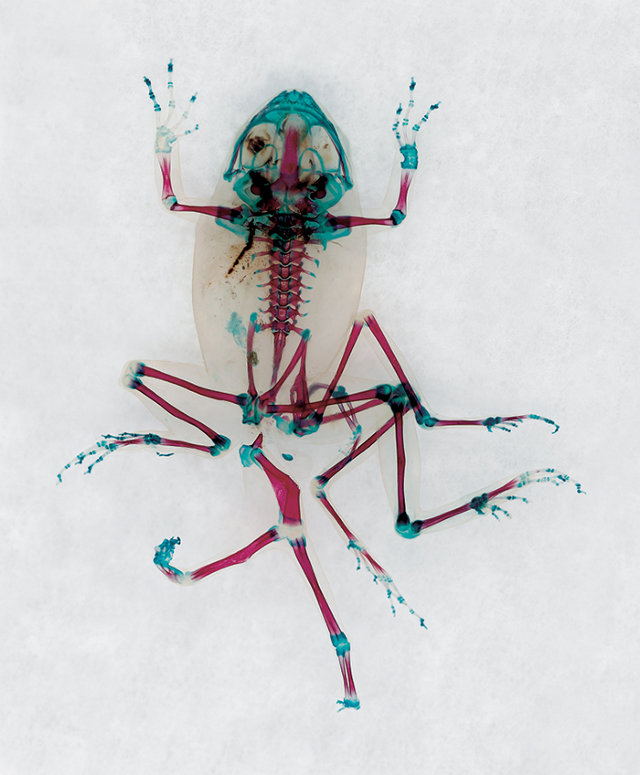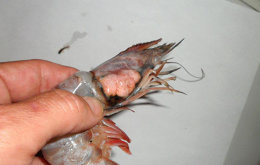Over the past 13 years, artist and biologist Brandon Ballengée has been collecting deformed baby amphibians, preserving them in formaldehyde, using enzymes to make their tissues transparent, and then injecting their bones and organs with colored dyes.
This might sound like the hobby of a serial killer. But it's actually work critical to learning how our changing environment affects the frogs and toads--and it tells a story that could explode popular understanding of how humans contribute to the problem.
 DFA 117: Galatée
DFA 117: Galatée. 2001/07
Ballengée first got involved with the amphibians in 1996, when he heard about a scarring middle school field trip in Minnesota that stumbled upon a community of frogs with multiple legs missing or sprouting from the bone. After that, he started volunteering with the United States Geological Survey's North American Reporting Center for Amphibian Malformations system, helping to hunt down the little oddities in the hopes of eventually explaining how they came to be. Ballangée started doing research on hotspots, areas with deformity ratios far higher than the average, and began collecting amphibians that were so disadvantaged that they had a slim chance at life, or were already dead.
At first, Ballangée presumed that some kind of toxic agrichemical was polluting the wetlands in which the amphibians lived. Many of the hotspots were near farms, where fertilizer runoff from the fields joined with local streams. "From recent studies, including my own, it seems more complicated than that," he says. Instead, Ballengée noticed two phenomena that could explain why the amphibians' legs looked the way they did.
 DFA 23: Khárôn.
DFA 23: Khárôn. 2001/07.
Here's the first: When fertilizer runoff, including nitrates or phosphates, enters streams, algae feed and grow on the influx of those nutrients. This is a process called eutrophication, and usually it'll turn a stream bright green with gristly chunks of plants and plankton. (If you've ever driven by or lived on a farm, that's why the ditches by the side of the road look the way they do.) Some aquatic snails, it turns out, feed on that algae. And those snails carry parasites called trematodes that can cause extra legs in frogs. Evidence increasingly shows that the more resources for parasites, the more legs for frogs.
Hotspots also occur in suburban areas. One of Ballengée's hypotheses is that nutrients from lawn maintenance could cause the same issues.

For more chemically induced animal deformities (always fun) check out these photos of what Gulf Shrimp looked like after the Deepwater oil spill.
The other explanation for the frogs' legs is much more violent. Some studies have shown that chemicals from mining can change amphibians' response to predators. Even at "safe" levels of contamination from copper mines, for example, tadpoles' reflexes slow down, which makes them more vulnerable to predators maiming them. Some ecosystems also support a terrifying hunter called the dragonfly nymph, which preys on frogs' hind legs (delicious).
"Dragonfly nymphs, they're a lot like the creatures from Alien. They shoot out a mouthpart, grab back their prey, and they have these little meat grinders that will just remove a leg," Ballengée says. "The tadpoles often will survive these attacks, but they're not able to regenerate a full limb depending on what stage of development they're at."
There's still much that's unknown about how frogs lose or gain legs, and which kinds of farming affect them the most. The kind of wetland destruction that bleeds agricultural runoff into amphibian habitat, though, is a likely culprit. Climate change, too, could yield significant changes for amphibians. As some areas get warmer, researchers have suggested that migratory birds will change their flight patterns. A few of those species, Ballengée adds, carry the same kind of parasite that infect amphibians with extra limbs.
 DFA 117: Galatée. 2001/07
DFA 117: Galatée. 2001/07 DFA 23: Khárôn. 2001/07.
DFA 23: Khárôn. 2001/07. For more chemically induced animal deformities (always fun) check out these photos of what Gulf Shrimp looked like after the Deepwater oil spill.
For more chemically induced animal deformities (always fun) check out these photos of what Gulf Shrimp looked like after the Deepwater oil spill.







No comments:
Post a Comment